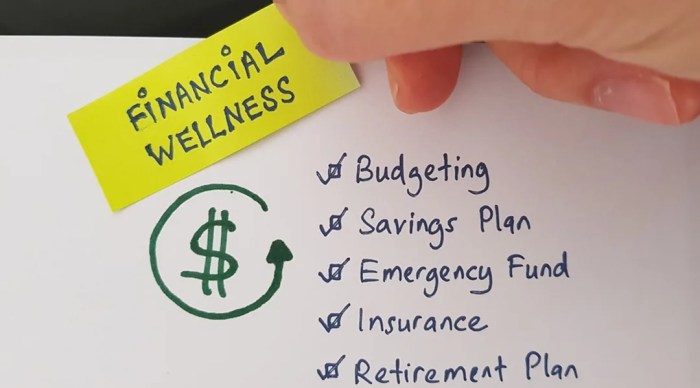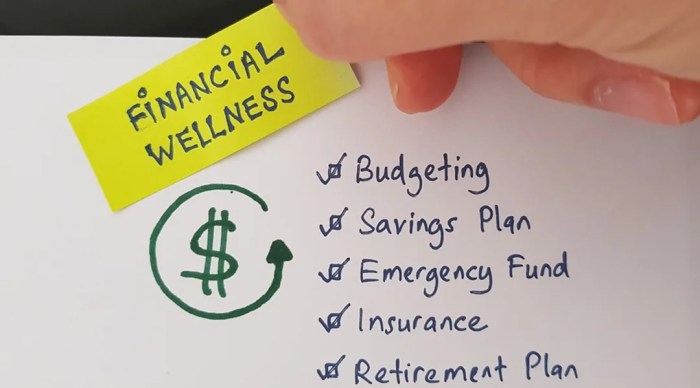Forget just counting your dollars. What if we told you there’s a whole new way to think about wealth, one that goes beyond your bank account and dives deep into your overall well-being? It’s called whole-health wealth, and it’s all about feeling amazing from the inside out, both financially and physically.
Ready to level up your life and unlock your true potential? Let’s dive in!
This guide will take you on a journey to understand how your physical, mental, emotional, social, and financial well-being are all interconnected. We’ll show you how to build a solid financial foundation, integrate whole-health practices into your daily life, and even explore a classic book that can help you reach your financial goals.
Defining Whole-Health Wealth

Forget just chasing the Benjamins! Whole-health wealth is about building a life that’s not just financially secure, but also thriving in every aspect. It’s about feeling good, inside and out, and living a life that’s fulfilling and balanced.
The Pillars of Whole-Health Wealth
Think of whole-health wealth as a foundation built on five strong pillars: physical, mental, emotional, social, and financial well-being. Each pillar contributes to your overall well-being, and a strong foundation in one area can help support the others.
- Physical well-being: This is all about taking care of your body. It includes things like eating a healthy diet, exercising regularly, getting enough sleep, and managing stress.
- Mental well-being: This involves taking care of your mind. It includes things like engaging in activities that challenge and stimulate your brain, practicing mindfulness, and seeking professional help when needed.
- Emotional well-being: This is about understanding and managing your emotions. It includes things like developing healthy coping mechanisms, building strong relationships, and seeking support when needed.
- Social well-being: This is about building and maintaining healthy relationships. It includes things like spending time with loved ones, engaging in your community, and fostering meaningful connections.
- Financial well-being: This is about managing your money effectively. It includes things like budgeting, saving, investing, and planning for the future.
Examples of How Each Pillar Contributes to Overall Well-being
Let’s break down how each pillar contributes to your overall well-being with some real-life examples:
- Physical well-being: Imagine you’re feeling physically fit and energized. You’re more likely to have the energy to pursue your goals, tackle challenges, and enjoy your relationships.
- Mental well-being: Picture yourself with a sharp mind and a positive outlook. You’re better equipped to make sound decisions, handle stress, and find solutions to problems.
- Emotional well-being: Think about the feeling of being emotionally stable and resilient. You’re better able to navigate difficult situations, build healthy relationships, and experience genuine joy.
- Social well-being: Imagine yourself surrounded by a strong network of supportive friends and family. You feel connected, valued, and less likely to experience loneliness or isolation.
- Financial well-being: Picture yourself feeling financially secure and confident. You’re less likely to experience stress or anxiety about money, and you have the freedom to pursue your passions and goals.
Building a Foundation for Financial Capability
Building a strong financial foundation is crucial for achieving whole-health wealth. It’s about taking control of your finances, making informed decisions, and setting yourself up for a secure future. Think of it like building a house – you need a solid foundation to support the rest of your life.
Budgeting: The Blueprint for Financial Success
A budget is your roadmap to financial stability. It helps you track your income and expenses, identify areas where you can save, and allocate funds towards your goals. By understanding where your money is going, you can make informed choices and avoid overspending.Here are some practical tips for creating and sticking to a budget:
- Track your spending for a month to get a clear picture of where your money is going. Use a budgeting app, spreadsheet, or notebook.
- Categorize your expenses to see where you can cut back. Identify unnecessary spending and look for ways to reduce costs in areas like housing, transportation, or entertainment.
- Set realistic financial goals, whether it’s saving for a down payment, paying off debt, or investing for retirement. This helps you stay motivated and prioritize your spending.
- Review your budget regularly and make adjustments as needed. Your financial situation can change over time, so it’s important to stay on top of your finances.
Saving: Building Your Financial Cushion
Saving is essential for financial security. It provides a safety net for unexpected expenses, allows you to pursue your goals, and helps you achieve financial independence.
So, you wanna build a life that’s not just financially stable, but totally awesome and healthy too? That’s the whole vibe of “Financially Capable A Friendly Guide to Building Whole-Health Wealth,” right? Think about it, if you’re constantly stressed about money, it’s hard to focus on your mental and physical well-being.
That’s where stories like “The Pastor’s Wife” The Pastor’s Wife can help. It shows how even seemingly perfect lives can have hidden financial struggles, and how building a solid foundation can make all the difference. You know, it’s all about creating that peace of mind so you can truly thrive.
- Set up an emergency fund with 3-6 months of living expenses. This will cover unexpected events like job loss, medical emergencies, or car repairs.
- Automate your savings by setting up regular transfers from your checking account to your savings account. This ensures you’re consistently building your savings.
- Consider opening a high-yield savings account to earn more interest on your savings. Explore options that offer competitive interest rates and minimal fees.
Investing: Growing Your Wealth Over Time
Investing is a powerful tool for building wealth and reaching your long-term financial goals. By investing your money, you can potentially earn returns that outpace inflation and grow your savings over time.
- Start small and invest regularly. Even small amounts can add up over time, especially with the power of compounding.
- Diversify your investments to spread risk. Don’t put all your eggs in one basket. Invest in a mix of assets, such as stocks, bonds, and real estate.
- Seek professional advice from a financial advisor if needed. They can help you create a personalized investment plan based on your risk tolerance and financial goals.
Resources and Tools for Financial Literacy
There are numerous resources available to help you enhance your financial literacy and make informed financial decisions.
- Financial education websites: Websites like Investopedia, NerdWallet, and the U.S. Securities and Exchange Commission (SEC) offer valuable information on budgeting, saving, investing, and other financial topics.
- Financial literacy courses: Many community colleges, universities, and non-profit organizations offer financial literacy courses, workshops, and seminars. These programs can provide practical skills and knowledge to improve your financial well-being.
- Financial advisors: If you need personalized financial guidance, consider consulting with a certified financial planner (CFP) or a registered investment advisor (RIA). They can provide professional advice and support to help you achieve your financial goals.
Integrating Whole-Health Practices

You’ve already started building a solid foundation for your financial capability, and now it’s time to level up your game by integrating whole-health practices. It’s about recognizing the interconnectedness between your physical, mental, and emotional well-being and your financial success.
When you prioritize your health, you unlock a superpower: the ability to make smart financial decisions, navigate challenges with resilience, and ultimately achieve your financial goals.
The Connection Between Whole Health and Financial Capability
Think of it like this: your physical, mental, and emotional well-being are like the three pillars of a strong financial foundation.
- Physical Health: When you’re physically healthy, you have more energy and focus to manage your finances effectively. You’re less likely to miss work due to illness, which can impact your income. Regular exercise and a balanced diet can improve your mental clarity and help you make sound financial decisions.
- Mental Health: A healthy mind is crucial for making wise financial choices. When you’re feeling stressed or anxious, you’re more prone to impulsive spending or making poor financial decisions. Cultivating mindfulness and stress management techniques can help you stay grounded and make informed choices.
Financially Capable is all about getting your money right, but let’s be real, sometimes you need a little inspiration to get your head in the game. Check out “The Temporal Path Book 1” The Temporal Path Book 1 , a wild ride through time that’ll make you think differently about what’s really important.
Then, you can come back to Financially Capable and start building your whole-health wealth with a fresh perspective!
- Emotional Well-being: Your emotional well-being plays a vital role in your financial journey. When you’re feeling secure and confident, you’re more likely to take calculated risks, invest wisely, and build a strong financial future.
The Benefits of Whole-Health Practices
Incorporating mindfulness, stress management techniques, and healthy lifestyle choices into your daily routine can have a significant impact on your financial well-being.
- Mindfulness: Mindfulness practices like meditation or deep breathing exercises can help you stay present, reduce stress, and improve your focus. This can lead to better financial decision-making and a more positive outlook on your financial situation.
- Stress Management: Stress can lead to impulsive spending and poor financial choices. Techniques like yoga, exercise, or spending time in nature can help you manage stress levels and make more rational financial decisions.
- Healthy Lifestyle Choices: Eating a balanced diet, getting regular exercise, and getting enough sleep are essential for both your physical and mental health. When you prioritize these aspects of your life, you’ll have more energy and focus to manage your finances effectively.
Financially Capable is all about taking control of your money, but don’t forget to take care of your mind and body too! Sometimes the best way to unwind is by tapping into your creative side, and what better way than with art?
Check out “Flowers Made Easy Vol 2: A Step by Step Beginner Friendly Flower Drawing Tutorial Book (Simple) (Drawings Made Easy)” here , and let your inner artist bloom! Just like with your finances, taking time for yourself can help you grow into a more balanced and happier person.
Sample Weekly Schedule
Here’s a sample weekly schedule that integrates financial planning with whole-health practices. You can adapt it to your own needs and preferences.
| Day | Financial Planning | Whole-Health Practices |
|---|---|---|
| Monday | Review your budget and track your spending. | Go for a brisk walk or do a yoga session. |
| Tuesday | Set aside time to research investment options. | Practice mindfulness meditation for 10 minutes. |
| Wednesday | Pay your bills and plan for upcoming expenses. | Prepare a healthy and nutritious meal. |
| Thursday | Review your financial goals and make adjustments as needed. | Engage in a relaxing activity like reading or listening to music. |
| Friday | Plan for your weekend and allocate time for fun activities. | Get a good night’s sleep. |
| Saturday | Catch up on any financial tasks that you didn’t complete during the week. | Spend time in nature or engage in a hobby you enjoy. |
| Sunday | Reflect on your financial progress and celebrate your achievements. | Practice gratitude and focus on the positive aspects of your life. |
Book Review: “The Total Money Makeover” by Dave Ramsey
Dave Ramsey’s “The Total Money Makeover” is a popular personal finance guide that has helped millions of people achieve financial freedom. Ramsey’s approach is rooted in the belief that debt is a major obstacle to financial well-being and that taking control of your finances requires a disciplined and structured approach.
Key Principles of “The Total Money Makeover”
Ramsey’s book Artikels a seven-step plan to eliminate debt and build wealth. The plan emphasizes the importance of budgeting, living below your means, and avoiding unnecessary spending. The seven steps are:
- Save $1,000 for an emergency fund.
- Pay off all debt except the house using the debt snowball method.
- Save three to six months of living expenses.
- Invest 15% of your household income.
- College funding for your children.
- Pay off your house.
- Build wealth and give generously.
The debt snowball method involves listing all debts from smallest to largest, regardless of interest rates, and paying off the smallest debt first while making minimum payments on the others. Once the smallest debt is paid off, the money that was used to pay it off is added to the payment on the next smallest debt, and so on.
Yo, listen up! “Financially Capable: A Friendly Guide to Building Whole-Health Wealth” is like the ultimate cheat code for your financial and wellness game. It’s got all the tips and tricks to level up your life, from crushing debt to building wealth and boosting your overall health.
Wanna dive in? Download And Listen Here and get ready to transform your life, one step at a time. “Financially Capable” is your guide to a brighter, healthier, and wealthier you!
This method is designed to provide motivation and momentum as you see your debts shrink and your payments increase.
Strengths of “The Total Money Makeover”
“The Total Money Makeover” is a practical and effective guide to personal finance. Its strengths include:
- Emphasis on Debt Elimination:The book’s primary focus is on eliminating debt, which is a major obstacle to financial well-being. By prioritizing debt elimination, Ramsey helps readers break free from the cycle of debt and gain control of their finances.
- Simple and Actionable Steps:The seven-step plan is straightforward and easy to understand, making it accessible to people of all financial backgrounds.
The steps are also actionable, providing readers with concrete steps they can take to improve their financial situation.
- Motivational and Encouraging:Ramsey’s writing style is motivational and encouraging, providing readers with the support and inspiration they need to stick to their financial goals.
He emphasizes the importance of having a positive mindset and believing in yourself.
Weaknesses of “The Total Money Makeover”
While “The Total Money Makeover” is a valuable resource, it does have some weaknesses. These include:
- Limited Focus on Investing:The book’s emphasis on debt elimination and saving can overshadow the importance of investing. While it does address investing, it does not provide in-depth guidance on different investment strategies or asset allocation.
- Rigid Approach:Ramsey’s approach to personal finance is often perceived as rigid and inflexible.
He strongly advocates against using credit cards and encourages a minimalist lifestyle. This approach may not be suitable for everyone, especially those who value flexibility and convenience.
- Lack of Consideration for Individual Circumstances:The book’s one-size-fits-all approach may not take into account individual circumstances, such as income level, family size, or career goals.
Some of Ramsey’s recommendations may not be feasible or appropriate for everyone.
Comparison with Other Financial Planning Strategies
“The Total Money Makeover” is just one of many popular financial planning strategies. Other popular approaches include:
- The FIRE Movement (Financial Independence, Retire Early):This movement emphasizes saving aggressively and investing early to achieve financial independence and retire early. The FIRE movement often encourages a more minimalist lifestyle and a focus on passive income streams.
- Index Fund Investing:This approach involves investing in low-cost, diversified index funds, which track a specific market index, such as the S&P 500.
This strategy is often recommended for long-term investors who are seeking to build wealth over time.
- Behavioral Finance:This approach recognizes the role of psychology and emotions in financial decision-making. Behavioral finance principles can help investors understand and overcome common behavioral biases that can lead to poor financial choices.
Ramsey’s approach to personal finance emphasizes discipline, debt elimination, and a focus on building wealth through saving and investing. While his methods are effective for many people, it’s important to consider other financial planning strategies and choose an approach that aligns with your individual circumstances and goals.
Last Point

Building whole-health wealth isn’t about becoming a financial guru overnight. It’s about taking small, intentional steps towards a happier, healthier, and more financially secure future. Remember, you’re not alone on this journey. There are tons of resources and tools available to support you, and by taking action and making small changes, you can achieve the whole-health wealth you deserve.
FAQ Insights
What are some practical examples of whole-health wealth?
Imagine having enough money to travel the world, eat healthy food, and pursue your passions without financial stress. That’s whole-health wealth in action! It’s about having the freedom and resources to live a life that aligns with your values and goals.
How can I incorporate mindfulness into my financial planning?
Mindfulness helps you stay present and make conscious financial decisions. Try taking a few minutes each day to reflect on your spending habits, set financial goals, and appreciate the progress you’re making.
Is whole-health wealth just for wealthy people?
Absolutely not! Whole-health wealth is about building a balanced and fulfilling life, regardless of your income level. It’s about prioritizing your well-being and making smart financial choices that work for you.

